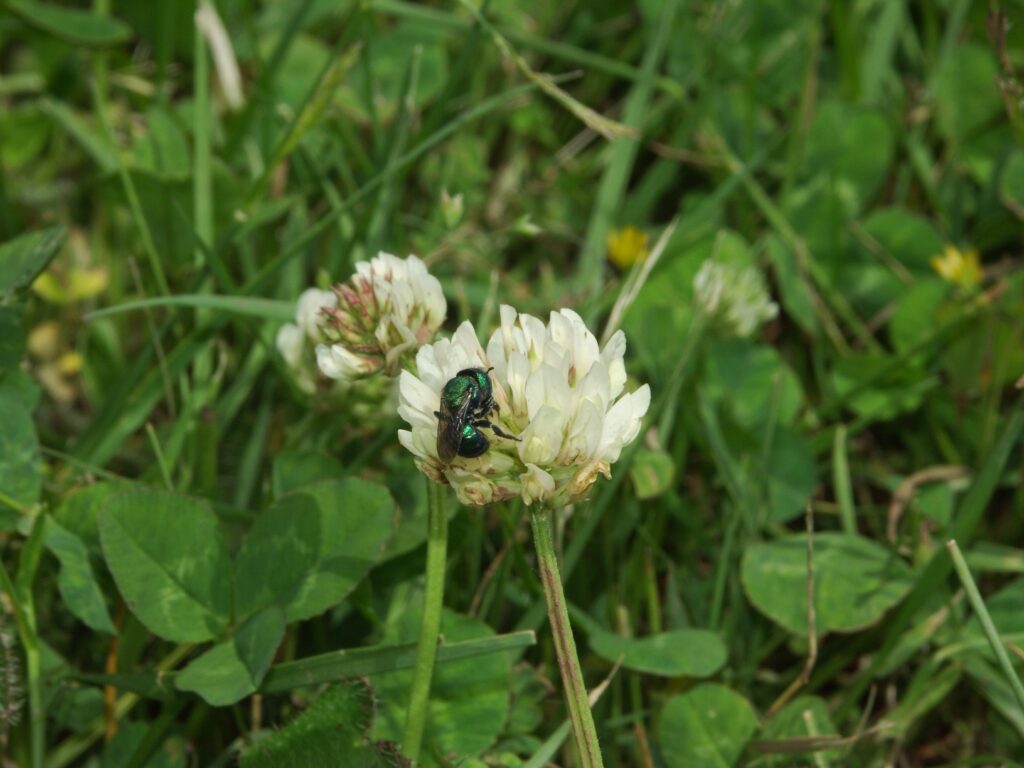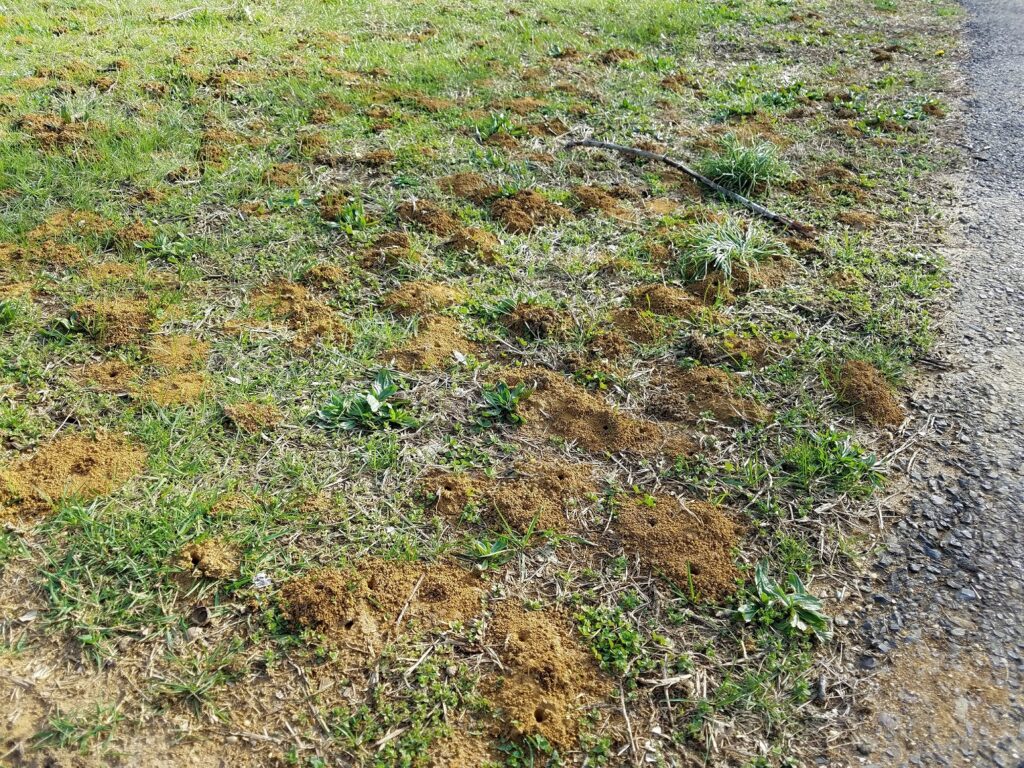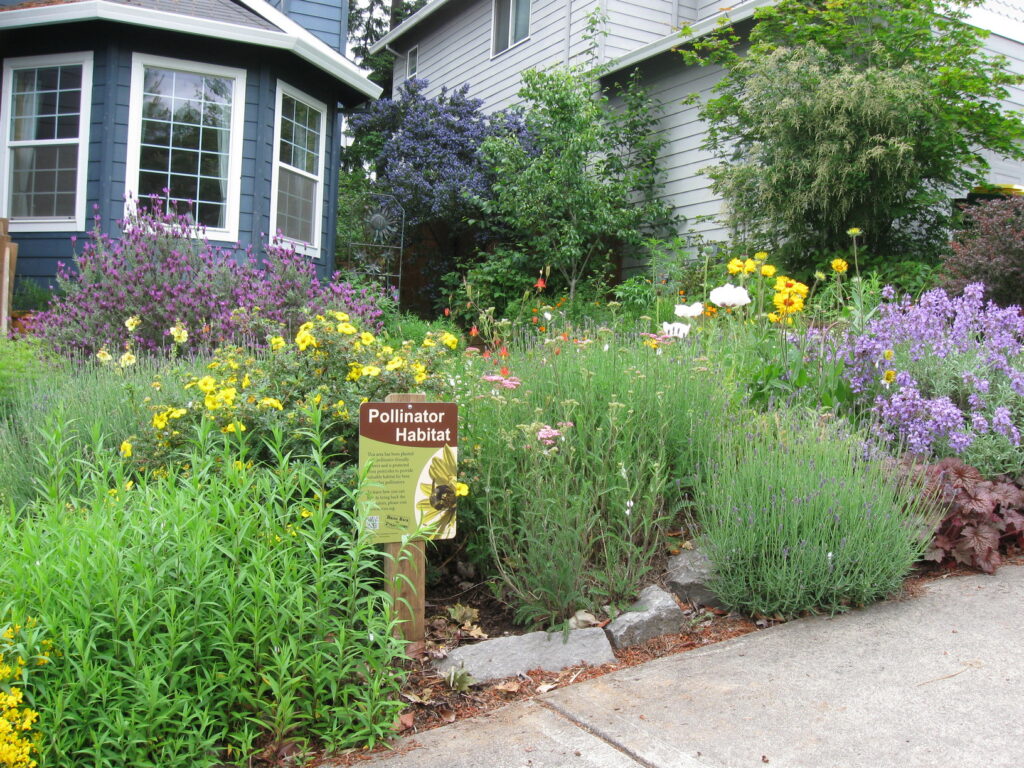This past month Bee City USA encouraged it’s over 250 affiliates to participate in No Mow May, a conservation initiative that encourages people to stop mowing for the month of May in order to create habitat and provide resources for bees and other pollinators. First popularized by Plantlife, an organization based in the United Kingdom, No Mow May is gaining traction across North America.
We were delighted by the response to No Mow May as well as the many questions and conversations it spurred. Inspired by conversations we’ve had throughout the month we compiled a list of your questions related to No Mow May and collaborated with a range of staff from across Xerces’ program areas to respond to them.
We invite you to approach No Mow May as one of many actions you take to conserve pollinators in your community. It will take a collective, long-term effort to shift the American landscaping paradigm toward a model that supports our ecological communities, not only our human ones. We hope this initiative will continue to spark constructive conversations and deliberate actions throughout the year.

How exactly will allowing my lawn to grow benefit pollinators?
Mowing your lawn less allows flowering plants to bloom, providing bees and other pollinators with the nectar and pollen that they rely on to feed themselves as well as their offspring. This is the primary benefit, giving flowers a chance to bloom uninterrupted and in greater abundance. Longer grass can also provide other benefits to invertebrates including shelter. The more varied structure created by longer grass will support more than just bees, including ground beetles as well as some species of butterflies that use grasses as host plants. The fiery skipper and sachem are two examples of butterflies whose caterpillars utilize lawn grasses. – Molly Martin, Bee City USA Coordinator
So, letting my lawn grow will be great for bees!
It won’t be great, but it will be better. Letting your lawn grow and having Dutch clover, dandelions, and other weeds flowering will mean there is something for bees to forage on, but many weeds are non-native, and don’t support a wide range of native bees. In addition, some lawn weeds may be invasive and need to be controlled. But it is a starting point for changing our neighborhoods into places that will support bees and other wildlife. – Matthew Shepherd, Director of Communications and Outreach
Given that my lawn is primarily turf grass and non-native weedy species, will I be spreading weeds by not mowing my lawn?
Because lawns are usually mown, the plants that grow there are species that tolerate those conditions. Both grasses and typical lawn weeds have buds that are low to the ground so they are able to resprout after each mowing and their roots tolerate the compacted soil that is caused by the frequent passing of the mower’s tires. Turfgrass and common lawn weeds may also grow in nearby compacted soil, but in general, they will not spread to other non-lawn areas, where different soil conditions and the presence of other perennial vegetation or tillage is beyond their “comfort zone.” – Stephanie Frischie, Agronomist, Native Plant Materials Specialist
Will the flowers in my lawn support a lot of bees?
While lawns are traditionally maintained as primarily monocultures of one of a handful of species of often non-native grass, many lawns also include a variety of native and non-native flowering species. Common examples of flowers found in lawns include dandelions and Dutch clover, but you may also have native species of clovers, violets, and selfheal. The number of bees that your unmown lawn supports depends on the species and abundance of flowers intermixed with the grass. A lawn without any flowering plants won’t benefit bees while one rich in a diversity of native species will attract lots of bees. Non-native plant species will provide some nectar and pollen to bees, however native plants will attract and support a greater variety of native bee species. Since many of the thousands of bee species native to North America are specialists, relying on the specific plant species that they evolved alongside, it’s important to do what you can to increase native plants in your lawn. – Molly Martin, Bee City USA Coordinator
I didn’t realize that there were so many types of bees. How many are there?
There are just over 3,600 species of bees in the U.S. and Canada: mason bees, sweat bees, mining bees, polyester bees, small carpenter bees, yellow-faced bees, leafcutter bees, long-horned bees, squash bees, carpenter bees, bumble bees, digger bees, and more! The largest (carpenter bees and bumble bees) may be 1.25” long, the smallest (tiny sweat bees and mining bees) 0.1” or less in length. Bees may be hairy or shiny, be black, brown, red, sparkling metallic green, or shimmering blue, have bands of yellow, orange, white, or change color depending on the light angle — not at all like the cartoon image of black-and-yellow and hairy. – Matthew Shepherd, Director of Communications and Outreach
I have ground-nesting bees. Should I let my grass grow?
This just illustrates that there is no “one size fits all” approach to gardening — or pollinator conservation! Some mining bees prefer to nest in locations with thin or patchy grass. In some places they are referred to as “lawn bees,” but now are widely known as “tickle bees” thanks to the amazing aggregation at an elementary school in Portland, OR. If you are lucky enough to have ground-nesting bees in your lawn, it will be better to keep mowing the area in which they are nesting. You’ll probably want to mow in the evening when the bees are not active, but walking or running a mower over their nests won’t harm them. They’ll be sheltering in their nest tunnels and will re-emerge the next morning. – Matthew Shepherd, Director of Communications and Outreach

People are strongly drawn to lawns and they are great for throwing a ball around or playing with our dog. What are some ideas for how to balance the desire for a lawn with creating habitat for pollinators and other wildlife?
The open expanses of yards and parks with a shorter layer of grasses and the shade of a few large trees are reminiscent of the savanna grasslands of early humans. These spaces offer some protection from the sun and a place to rest, relax, or play with an open vista that assures no imminent danger is nearby. Ecological anthropologists suggest that the deep human connection to savanna grasslands has shaped the way we design and manage lawns and parks. As your space and household needs allow, consider dedicating a smaller portion of your yard to lawn that is mowed. The spaces you’ve gained can be used to grow a range of native or non-invasive pollinator-friendly plants such as shrubs, flowers (annuals and perennials), a border of bunch grasses, vegetables, herbs, or berries. Another option for areas that won’t get a lot of foot traffic but where shorter vegetation or less mowing is valued, is to sow naturally short grasses or grass-like plants such as buffalo grass and rushes, as well as selfheal or violets. – Stephanie Frischie, Agronomist, Native Plant Materials Specialist
I would like to participate in No Mow May but my community has rules that restrict me from letting my lawn grow unmown. What do you recommend that I do?
If letting your lawn grow is not possible due to your community’s landscaping rules, there are several other options for making your yard, patio, or balcony more pollinator-friendly. You can reduce the amount of lawn that is turfgrass and fill those areas with landscaping full of plants that provide host plants, nectar, pollen, nesting materials, nest sites, and shelter from harsh weather. Even a window box or planter can be a place to provide more habitat and resources for pollinators. You could also revisit the vegetation policies of your HOA or local government. As attitudes change around sustainability topics such as mowing, pesticide use, and native landscaping, restrictive landscaping rules are increasingly out of step with the growing numbers of residents like yourself who want to plant and care for their yards and community green spaces in ways that are healthy and attractive for pollinators, wildlife, and people. – Stephanie Frischie, Agronomist, Native Plant Materials Specialist
Is the month of May the best time in my region to let my lawn grow?
In many regions of the United States the month of May corresponds with bees emerging from their nests in search of energy in the form of nectar and pollen. The vast geographic size of this country means that we have huge regional variation in the timing of bee emergence, and therefore while May is a good time to reduce mowing to encourage floral resources in some areas it may not be the best time in your region (No Mow April?). Keeping an eye out for early season bees and growth of plants in your yard is a great way to judge when it would be most beneficial to reduce mowing. – Molly Martin, Bee City USA Coordinator
Does using pesticides on my lawn negatively affect pollinators and other invertebrates using the habitat?
Unfortunately, common lawn and garden pesticides can harm pollinators and other invertebrates. Many of the insecticides you find on store shelves are broad-spectrum, meaning that they can harm a wide range of insects including important beneficials. Avoiding insecticide use is key to maintaining healthy pollinator habitat, but herbicides and fungicides can also have impacts so we recommend avoiding all pesticide use in yards and gardens. This ensures a healthy ecosystem for both your family and pollinators using your habitat. You can read more about pesticide-free pollinator gardening here. – Sarah Hoyle, Pesticide Program Specialist
What are the alternatives that will allow me to maintain an attractive lawn?
Turfgrass on its own does not provide food for pollinators. However, small changes in lawn management, encouraging a mix of grasses and low-growing flowering perennials, can make a big difference for pollinators. Flowering lawns are also lower-maintenance; rather than spending time and resources attempting to destroy all plants except grasses, a diversity of plants — including violets, selfheal, and clovers — are encouraged. Preventative maintenance strategies, such as ensuring aeration to support grass roots, and proper watering to keep lawns healthy can help limit weed growth. Manage any unwanted weeds through physical methods, and reseed areas where weeds are removed or turf has been damaged. To keep your lawn healthy, consider applying a thin layer of compost in the spring, and leaving grass clippings in place. – Aimée Code, Pesticide Program Director
What can I do to educate my neighbors and passersby about my yard choices and how they benefit pollinators?
Taking the simple step of communicating why you’ve made the landscaping choices you have to your neighbors and other passersby can help others understand that by not mowing you have made an intentional decision to create habitat for wildlife rather than neglected your yard. Putting up signs can be an easy and effective way to educate others about the benefits of reducing mowing for bees and other pollinators. Signs may also spark conversations and encourage your neighbors and visitors to consider their own yard and actions they can take to create better habitat. Visit Bee City USA’s No Mow May webpage to download free artwork for signs. – Molly Martin, Bee City USA Coordinator

What are other steps I can take on my own property to benefit pollinators year round?
Reducing mowing for a single month is a relatively easy step that you can take to provide bees and other invertebrates with the resources they rely on, but there are many other additional steps you can take to improve your habitat year round. The three most important things you can do to support bees on your property are to plant regionally native plant species, provide natural nesting areas, and reduce or eliminate the use of pesticides. If you’re interested in taking the next step in turning your lawn into better habitat for pollinators, consider converting it to a pollinator-friendly lawn or removing your lawn entirely and replacing it with native plants. – Molly Martin, Bee City USA Coordinator
So No Mow May is just a starting point?
Yes, No Mow May is just a beginning, an initial step in making our urban landscapes less inhospitable to bees and other pollinators. No Mow May is a great opportunity to shine a spotlight on the needs of native bees and highlight the problems with what might be called “typical” lawn care and gardening. Pausing mowing for one month will bring some benefits, but native bees need more than dandelions and other lawn weeds. To truly have a lasting impact, we need to reduce the area devoted to lifeless lawns and replace them with native plantings. And we need to be providing for the whole life cycle of bees. Pollinator conservation is a year-round activity, not just something that happens for one month. – Matthew Shepherd, Director of Communications and Outreach
5/2022 Addendum:
What about ticks?
We recommend maintaining a mowed buffer near your house or in high-traffic areas in tick-heavy areas. Ticks prefer shade, so creating gravel, bark or mulch borders (about 3 feet wide) between sunny lawns and shady forests can reduce their numbers in the grass. Rodents and deer are carriers, so planting deer-resistant plants and discouraging rodent habitat can also reduce ticks near your home. Replacing lawns with ferns, herbs and other plants can also help.
For more information see our guide: Smarter Pest Management: Protecting Pollinators at Home (page 7) and Tick Management Handbook by the Connecticut Agricultural Experiment

Additional Resources
Bee City USA Resources – No Mow May
Bee City USA Resources – Pollinators
Bee City USA Resources – Plants
Bee City USA Resources – Pesticides
Xerces Society Pollinator Conservation Resource Center
BlueThumb.org: Pollinator-Friendly (Bee) Lawn
University of Minnesota Bee Lab
Guidance from Natural Resources Defense Council: More Sustainable (and Beautiful) Alternatives to a Grass Lawn





